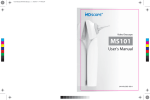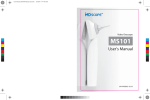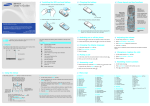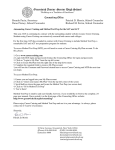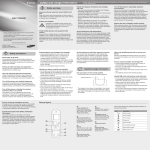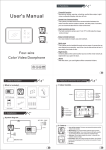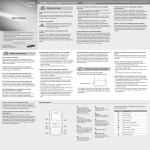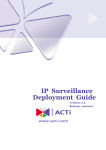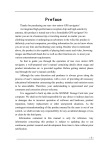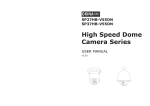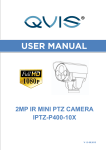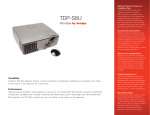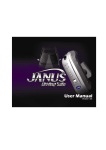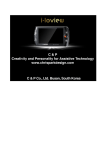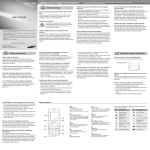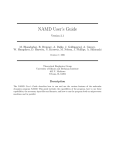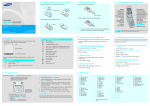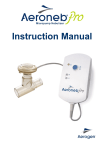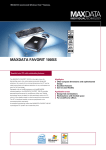Download User`s Manual
Transcript
User Manual -. 20130314 -24page .ai 1 2013/5/17 T 午 04:42:57 Video Otoscope C M MS101 Y CM MY User’s Manual CY CMY K UM-AP1005-08-A User Manual -. 20130314 -24page .ai 2 2013/5/17 T 午 04:43:00 ® Thank you for choosing the MDSCOPE Video Otoscope, the Video Otoscope choice for health care professionals. The operating and maintenance instructions found in this manual should be followed to ensure product reliability. Please read this manual carefully before using the product. If you experience a technical problem related to operation of the ® MDSCOPE Video Otoscope, please contact your local dealer for the after-sales support. You may also contact the customer service at +886 2 2999-5505 or [email protected] C M FDA listed: V D083901, D119968, D150295 CM IEC 60601-1, IEC 60601-1-2 MV CV CMV When there is a need to immediately report an adverse effect in connection with operation of the MDSCOPE® Video Otoscope, please contact the K authorized representative or the agent. You may also contact the customer service at +886 2 2999-5505 or [email protected] U.S. Agent: Harvest Consulting Corp. Medical Device Safety Service GmbH 2904 N, Boldt Drive, Flagstaff Schiffgraben 41, 30175 Hannover Arizona 86001, U.S.A. Germany The manufacturer declares on his/her sole responsibility that the product is in conformity with the essential requirements of the 93/42/EEC Medical Device Directive, and that the relevant conformity assessment procedures have been fulfilled. ©2012 by Apple Biomedical, Inc. All Rights reserved. Reproduction or reprinting of any part of this manual by any means without written authorization from Apple Biomedical Inc. is strictly prohibited. Printed in Taiwan. 01 User Manual -. 20130314 -24page .ai 3 2013/5/17 T 午 04:43:00 Contents 1 Introduction Chapter 1 Introduction ................................................ 03 The MDSCOPE Video Otoscope is a hand-held medical device that includes a video camera for capturing a video image of the outer ear canal and/or tympanic membrane. The image is displayed directly on a built-in screen or displayed on an external display device via connec® tion to a video out port. The MDSCOPE video otoscope is preset for its focus, brightness level and white balance. It is powered by two AA batteries for a continuous operation of about 4 hours. Features ...................................................... 04 Symbols ........................................................ 05 Saftey and Cautions .................................... 06 Use of Long/Flexible Camera Module .......... 07 Chapter 2 Operations.............................................................08 C Setting up the Otoscope ............................... 08 M Loading the Batteries ................................... 09 V Power ON / OFF ........................................... 10 Batteries Condition ..................................... 10 Image Freeze / Release Function .............. 10 Video Out Function ..................................... 10 CM MV CV ® Video imaging provides several advantages over direct visualization. ® The MDSCOPE video otoscope may be operated with an image dongle to record the otoscopic images which are used to create ® medical history for each patient. By using the MDSCOPE video otoscope, health professionals can review and discuss the clinical findings with patients to enhance the doctor/patient interaction. CMV Chapter 3 Specifications ............................................ 11 K Chapter 4 Cleaning and Storage ................................ 12 Chapter 5 Troubleshooting ........................................ 13 Chapter 6 Parts .......................................................... 14 Chapter 7 Limited Warranty ........................................16 Appendix EMC Guidance and Manufacturer’s declaration (Tables 201, 202, 204, 206) ........................17 02 Intended use ® The MDSCOPE video otoscope is as an assistive tool to observe the health condition of the ear. Indications for use include: Inspection of the outer ear canal and tympanic membrane, and detection of hearing aid devices. The device may also be coupled a flexible camera module to monitor the health condition of the mouth. Indications for use include inspection of palate, tongue and anterior of oropharynx. ® The MDSCOPE video otoscope should not be used for any other purposes. 03 User Manual -. 20130314 -24page .ai 4 2013/5/17 T 午 04:43:01 Symbols MS101 features Safety Symbols Screen Camera module Power indicator Fastening Ring Manufacturer Serial number Caution Not protected against the ingress of water +49°C ON/OFF button C -20°C M Image Freeze button ____ V Release button Type BF Temperature limits Symbol for "AUTHORIZED REPRESENTATIVE IN THE EUROPEAN COMMUNITY" CE mark has been identified according to Article 17 of the MDD(93/42/EEC ) CM Battery Cover MV CV CMV K Consult instructions for use video out port Button Symbols Power 04 Press Video out 05 User Manual -. 20130314 -24page .ai 5 2013/5/17 T 午 04:43:01 Saftey and Cautions ® The MDSCOPE video otoscope should be operated under supervision of a trained ENT doctor or health professionals with sufficient knowledge of otoscopy. *Under an extreme laboratory test condition at 40°C, the applied part of the device may be measured at a temperature of no higher than 60°C and its enclosure at 49°C if it is turned on continuously for more than 2 hours. *Do not use this device in the presence of inflammable anesthetics. *Please follow local rules and regulations regarding disposal or recycling of the device and its components. Suggested Use of Long/Flexible Camera module (For User purchasing the long/flexible camera modules) *The Video signal output (RCA Port) connector is intended for C connection to devices that comply with IEC 60601-1, or other IEC The long camera module is selected when it is difficult to get near to M standards (for example, IEC 60950), as appropriate to the device. the target using the standard camera module. As the MDSCOPE® V *Do not apply alcohol, chemicals, or water to clean the lenses. Solution entering the optical assembly can cause short-circuits CM for electrical components. MV *Portable and mobile wireless communications device which CV CMV K video otoscope is operated with the long camera module, the user needs to ensure that the tip of the camera module is held a distance NOT less than 1cm away from the target in the ear canal. The flexible camera module is selected when it is difficult to get near to transmits radiofrequency (RF) may affect the performance of the target using the long camera module. As the MDSCOPE® video the medical electrical device. otoscope is operated with the flexible camera module, the user needs *Please remove the batteries if the device is stored for a long time. to ensure that the tip of the camera module is held a distance NOT less than 1cm away from the target in the oral cavity. *Some patients may feel warm and uncomfortable at the probe during the diagnosis when the device is left switched ON for a long period of time. The operator of the device should first discuss the possible discomfort with the patient, and when necessary withdraw the device from the patient and switch it off until the probe no longer feels warm. WARNING: No modification of this equipment is allowed. 06 07 User Manual -. 20130314 -24page .ai 6 2013/5/17 T 午 04:43:01 2 Operations Loading the Batteries Setting up the Video Otoscope 1. Push the release button. 1. Remove the fastening ring. 2. Slide down to open the battery cover. 2. Align the camera module to the mounting base. 2.1 Remove the protective cover. C M Insert the camera module V to the mounting base via the mating parts CM MV 3. Load in the batteries. CV 3. Screw on the fastening ring. CMV 4. Put on new speculum before using. K 3.1 Align the fastening ring. 3.2 Screw it down to tighten. (Do not overtighten) 4.1 CAPPING: Push the flanged end onto the camera module until it clicks into a lock position. 4.Put the battery cover back on. 4.2 REMOVE : Press the flanged end of the rigid speculum to remove and discard after use. 08 09 User Manual -. 20130314 -24page .ai 7 2013/5/17 T 午 04:43:02 Power ON/OFF C Press and hold the power button for 2 seconds to switch the device on. M V CM Image Freeze / Release Function MV Battery Conditions When the light switches from green to red, it indicates that the batteries are low. In this case, please change batteries. Video Out Function “Video out” port CV CMV K 1. Remove the battery cover. 2. Remove the video out cover. When the power is turned ON, Press the image freeze button for less than 1 second to freeze the image, and press the same button again to return to preview mode. 10 4. Connect one end of the video out cable to the video out port and the other end to the monitor video port 3 Specifications Item Specifications Dimensions (approximate) Length : 7.5 cm (3") Width : 6.3 cm (2-1/2") Height : 21.2 cm (8-3/8") Focal length/distance 1 to 4 cm away from target Weight Approximately 180 g Batteries 2 x AA Alkaline batteries Display size 2.4" TFT LCD Video out NTSC system Operating conditions Temperature Relative humidity +10° C to +40° C (+50° F to +104° F) 30% to 75% non-condensing Shipping / Storage conditions Temperature Relative humidity Predicted product life -20° C to +49° C (-4° F to +120° F) 95% non-condensing max 2 years 11 User Manual -. 20130314 -24page .ai 8 2013/5/17 T 午 04:43:02 4 Cleaning and Storage 5 Troubleshooting For cleaning of the camera probe 1. Why is the MDSCOPE video otoscope not switched ON? 1st Step: Take out the alcoholized prep-pad. 2nd Step: Clean and wipe the stainless steel part of the standard/long camera module or the outer sheath of the flexible camera module with the alcoholized prep-pad. 3rd Step: Gently clean the camera lens with the cotton swab. Care should be taken not to scratch the lens of the camera module. For cleaning of the main unit The housing of the main unit can be cleaned with a cloth dampened with water, alcohol, or a non-staining disinfectant. Liquids should not be dripped or spilled over the surfaces of the LCD module, pogo pins or handle as they are not watertight. C M V CM MV Storage The camera module and main unit should be placed in the storage compartment of the carrying case. Unnecessary exposure to extremes in temperature and humidity should be avoided. CV CMV K ® 1. Please confirm the batteries have power and reload the batteries in the battery compartment. 2. Check and confirm the batteries are positioned in correct orientation. 3. Check and confirm the button can be depressed with ease, and repeat at least 10 times. 4. If the device is NOT switched ON by repeating the above steps, please contact your local dealer for technical supports. 2. After the device is switched ON, the power indicator light is ON but no image is displayed or the image is fuzzy and unstable. 1. Confirm if the LED light in front of the camera module is switched ON. 2. Confirm if camera module is mounted properly. 3. Confirm if the fastening ring is tightened up. 4. Confirm if there is any foreign substance stuck on the metal contact and clean the surface of metal contact with alcoholized prep-pad. 5. If the image is still NOT displayed properly after carrying out steps 14 above, please contact your local dealer for technical supports. 3. The device is switched ON with image displayed but I can’t freeze the image. 1. Restart the device and try the freeze function again. 2. Check and confirm the button can be depressed with ease, and repeat at least 10 times. 12 3. The main unit may be defective if the freeze function does not work after repeating the above steps for several times. Please contact your local dealer for technical supports. 13 User Manual -. 20130314 -24page .ai 9 2013/5/17 T 午 04:43:03 6 Parts Parts List Basic Parts W arranty card 5 C M V Item 1 2 3 4 5 6 7 8 9 Number MS101-001 MS101-002 MS101-003 MS101-005 MS101-006 MS101-007 MS101-008 MS101-016 MS101-017 Description Main device Camera module (45mm) Protective cover Video cable User manual Warranty card “AA” Alkaline batteries Disposable Specula Cotton Swab Quantity Description Image Dongle With USB cable Long camear module (75mm) Flexible camera module (150mm) Flexible camera module (300mm) Disposable Specula Cable Set Quantity 1 1 1 1 250 1 1 1 2 1 1 1 2 24 25 6 8 7 4 10 9 3 14 15 CM MV CV Optional Parts CMV K Item 10 11 12 13 14 15 Number MS101-011 MS101-012 MS101-013 MS101-014 MS101-015 MS101-018 2 11 12 13 1 14 15 User Manual -. 20130314 -24page .ai 10 2013/5/17 T 午 04:43:03 7 Limited Warranty ® Each of the MDSCOPE video otoscope comes with a one-year warranty, starting on the purchase date to cover repair and/or if necessary replacement of any product failure due to defects in materials and workmanship. Within the limited range of the warranty, defective products shall be repaired or replaced by the Manufacturer or authorized technical and service groups at their options and to the extent permitted by law. Appendix Table 201 Guidance and manufacture's declaration-electomagnetic emissions ® The MDSCOPE video otoscope is intended for use in the electromagnetic environment specified below. The customer or the users of the device should assure that it is used in the such an environment. Emissions test Compliance Electromagnetic environment - guidance RF emissions CISPR11 Group 1 The device uses RF energy only for its internal function. Therefore, its RF emissions are very This warranty is non transferable. Damages due to negligence, accident, abuse, misapplication, modification, or repairs not made by the Manufacturer, or authorized technical and service groups, are not covered by the warranty. Within the coverage of the warranty, the delivery fee for mailing to the local dealer or the direct store is not covered within the scope of the warranty. C M V CM MV low and are not likely to cause any interference in nearby electronic equipment. The device is suitable for use in all establishRF emissions CISPR11 Class B ments, including domestic establishments and those directly to the public low-voltage power supply network that supplies building CV used for domestic purposes. CMV K 16 EU Representative: Medical Device Safety Service GmbH Schiffgraben 41, 30175 Hannover Germany Harmonic emissions IEC 61000-3-2 Not Applicable Manufacturer: APPLE BioMedical Inc. 8th Floor, No.12, Lane 609, Chong Shin Road Sec.5, New Taipei, 24159, Taiwan. Voltage fluctuations/ flicker emissions IEC 61000-3-3 Not Applicable 17 User Manual -. 20130314 -24page .ai 11 2013/5/17 T 午 04:43:03 Table 202 Guidance and manufacture's declaration-electomagnetic immunity Table 204 Guidance and manufacture's declaration-electomagnetic immunity The MDSCOPE® video otoscope is intended for use in the electromagnetic environment specified below. The customer or the user of the device should assure that it is such an environment. The MDSCOPE® video otoscope is intended for use in the electromagnetic environment specified below. The customer or the user of the device should assure that it is such an environment. Immunity test Electrostatic discharge (ESD) IEC 61000-4-2 C M V CM MV CV CMV K IEC 60601 test level ± 6 kV contact ± 8 kV air Compliance level ± 6 kV contac t ± 8 kV air Electrical fast ± 2 kV for power transient /bursts supply lines IEC 61000-4-4 ± 1 kV for input/output lines Not Applicable Surge IEC 61000-4-5 ±1 kV line(s) to line(s) Not Applicable Voltage dips, short interruptions and voltage variations on power supply input lines IEC 61000-411 < 5 % UT (>95 % dip Not in UT) for 0,5 cycle Applicable Power frequency magnetic field IEC 61000-48 3 A/m ±2 kV line(s) to earth Electromagnetic environment guidance Portable and mobile RF communications equipment should be used no closer to any part of the device, including cables, than the recommended separation distance calculated from the equation applicable to the frequency of the transmitter. Recommended separation distance d=1,2√P Radiated RF 3 V/m IEC61000-4-3 80 MHz to 2,5 GHz 3 V/m d =1,2√P 80MHz to 800 MHz d =2,3√P 800 MHz to 2,5 GHz where P is the maximum output power rating of the transmitter in watt (W) according to the transmitter manufacturer and d is the recommended separation distance in meters(m). Field strength from fixed RF transmitters, as determined by an electromagnetic site survey, a should be less than the compliance level in each frequency rangeb . Interference may occur in the vicinity of equipment marked with the following symbol: 40 % UT (60% dip in UT) for 5 cycle s 70 % UT (30% dip in UT) for 25 cycles < 5 % UT (>95 % dip in UT) for 5 s 0,3 A/m IEC 60601 Complianc Electromagnetic environment - guidance test level e level Conducted RF 3 Vrms Not IEC61000-4-6 150 kHz to 80 Applicable MHz Floors should be of wood, concrete or ceramic tiles. If the floor is tiled with synthetic material the relative air humidity must have 30 % at least. If image distortion occurs, it may be necessary to position the device image intensifier further from sources of power frequency magnetic fields or to install magnetic shielding. The power frequency magnetic field should be measured in the intended installation location to assure that it is sufficiently low. NOTE : UT is the a.c. mains voltage prior to application of test level. 18 Immunity test NOTE 1: At 80 Hz and 800 MHz, the higher frequency range applies. NOTE 2: These guidelines may not apply in all situations. Electromagnetic propagation is affected by absorptions and reflections from structures, objects and people. Field strength from transmitters such as base stations for radio (celluar/cordes) telephones and mobile radio, amateur radio, AM and FM radio and TV broadcast cannot be predicted theoretically with accuracy. To assess the electromagnetic environment due to fixed RF transmitters, an electromagnetic site survey should be considered. If the measured field strength in the location in which the device is used exceeds the applicable RF compliance above, the device should be observed to verify normal operation. If abnormal performance is observed, additional measures may be necessary, such as re-orienting or relocating the device. a b Over the frequency range 150 kHz to 80 MHz, field strength should be less than 3 V/m. 19 User Manual -. 20130314 -24page .ai 12 2013/5/17 T 午 04:43:03 Table 206 Recommended separation distances between portable and mobile RF communications equipment and the MDSCOPE® Video Otoscope The device is intended for use in an electromagnetic environment in which radiated RF disturbances are controlled. The user of the device can help prevent electromagnetic interference by maintaining a minimum distance between portable and mobile RF communication equipment (transmitters) and the device as recommended below, according to the maximum output power of the communications equipment. Rated maximum output power of transmitter W C Separation distance according to the frequency of transmitter m 150 kHz to 80 MHz d=1,2√P 150 kHz to 80 MHz 150 kHz to 80 MHz d=1,2√P d=1,2√P M 0,01 0,12 0,12 0,23 V 0,1 0,38 0,38 0,73 1 1,2 1,2 2,3 10 3,8 3,8 7,3 100 12 12 23 CM MV CV CMV For transmitters rated at a maximum output power not listed above, the recommended separation distance d in the meters (m) can be estimated using the equation applicable to the frequency of the transmitter, where P is the maximum output power rating of the transmitter in watts (W) according to the transmitter manufacture. K NOTE 1: At 80 Hz and 800 MHz the separation distance for the frequency range applies. NOTE 2: These guidelines may not apply in all situations. Electromagnetic propagation is affected by absorptions and reflections from structures, objects and people. 20












